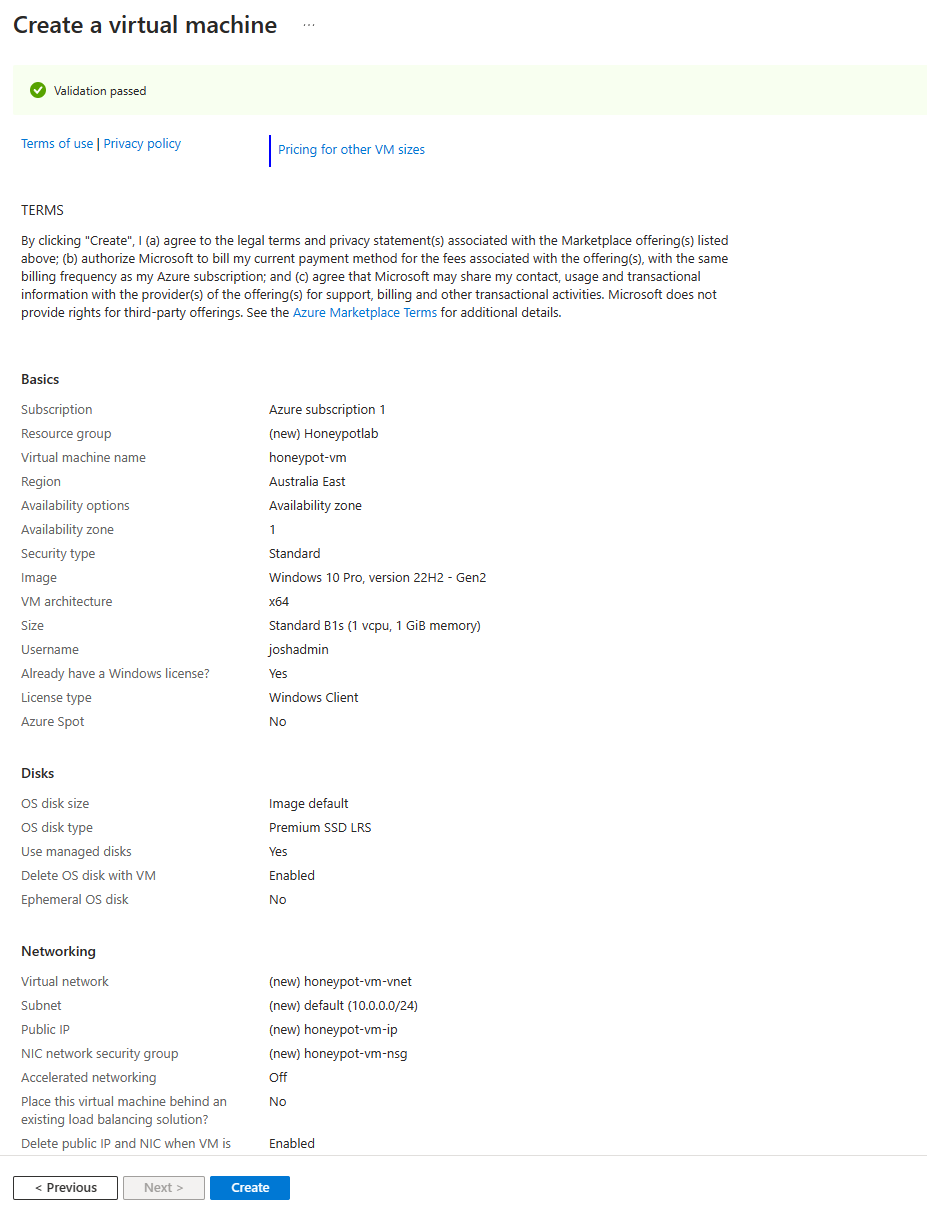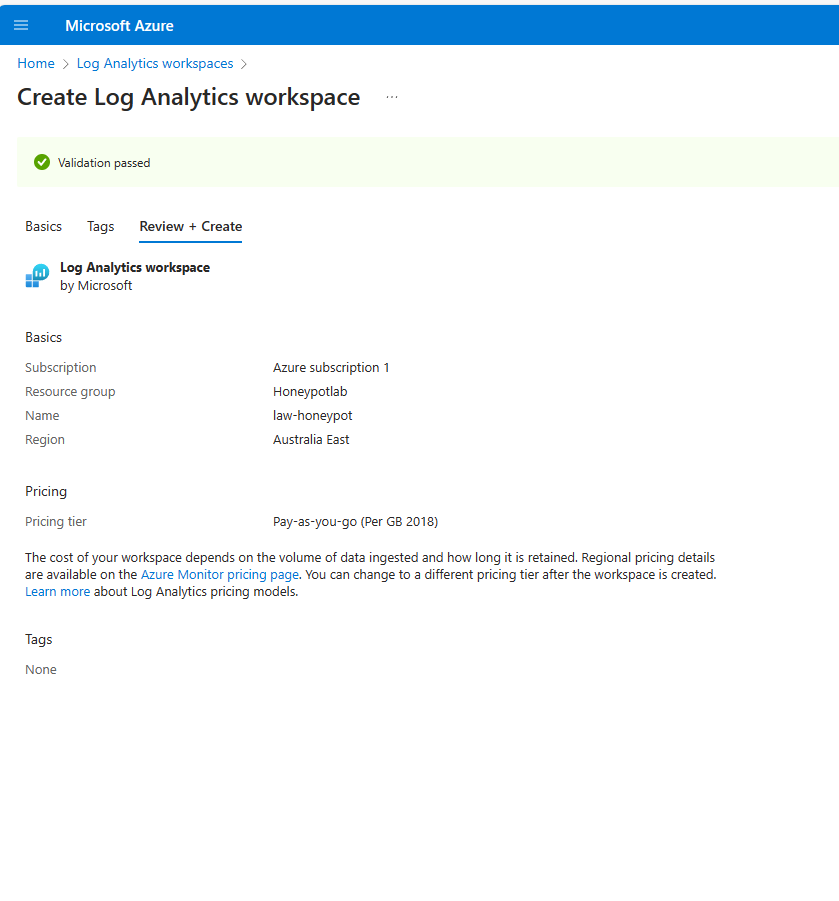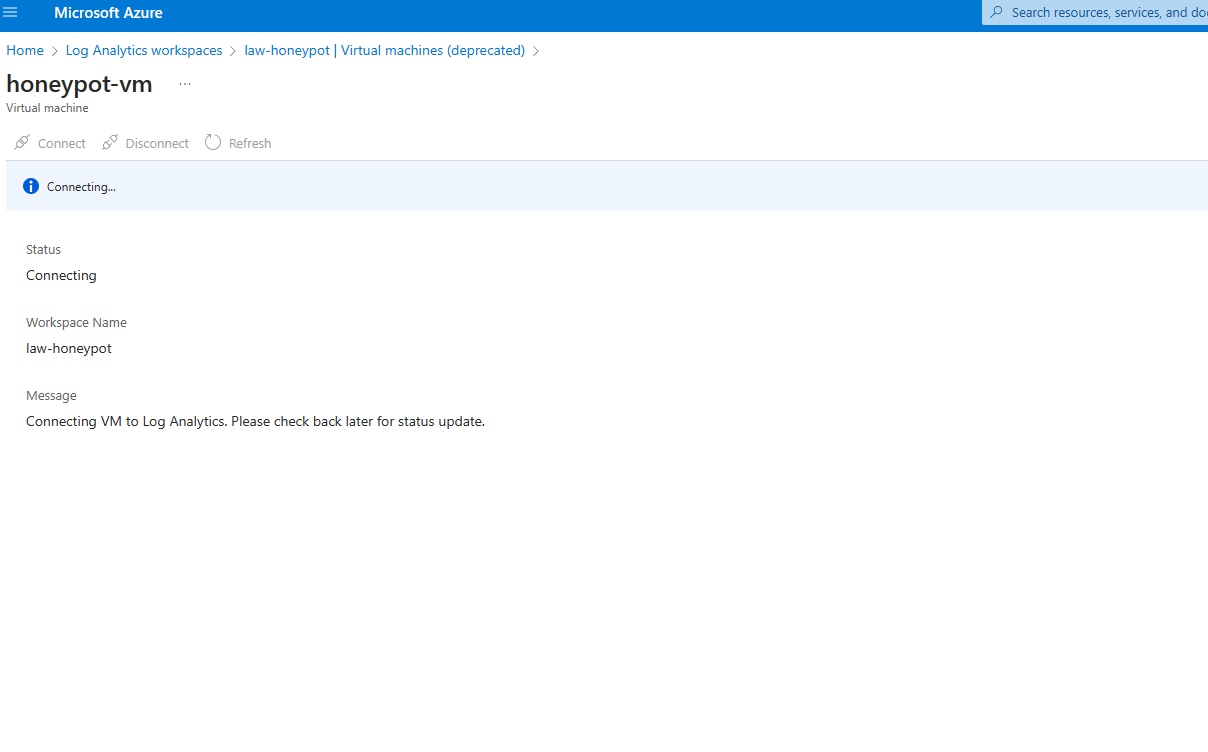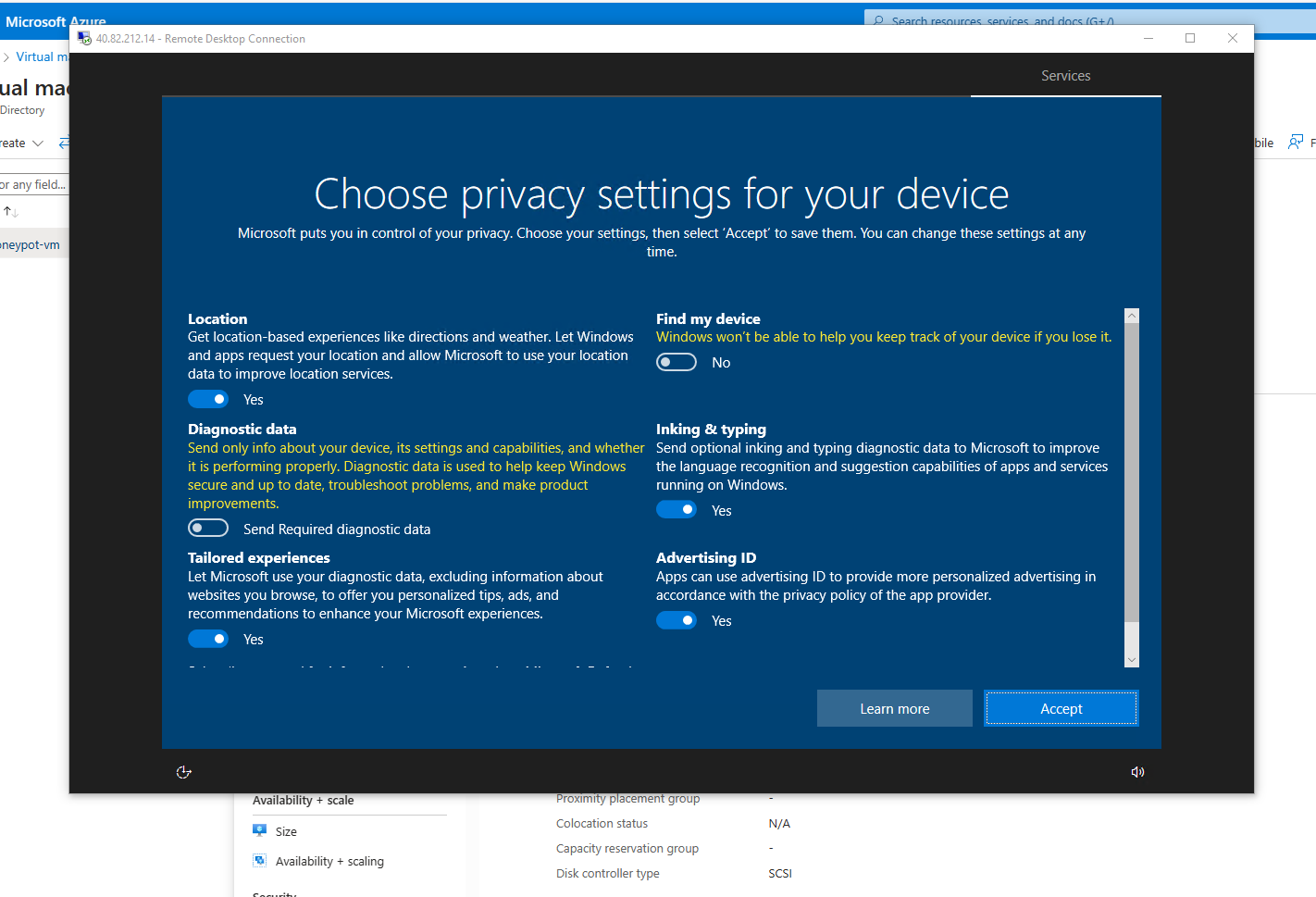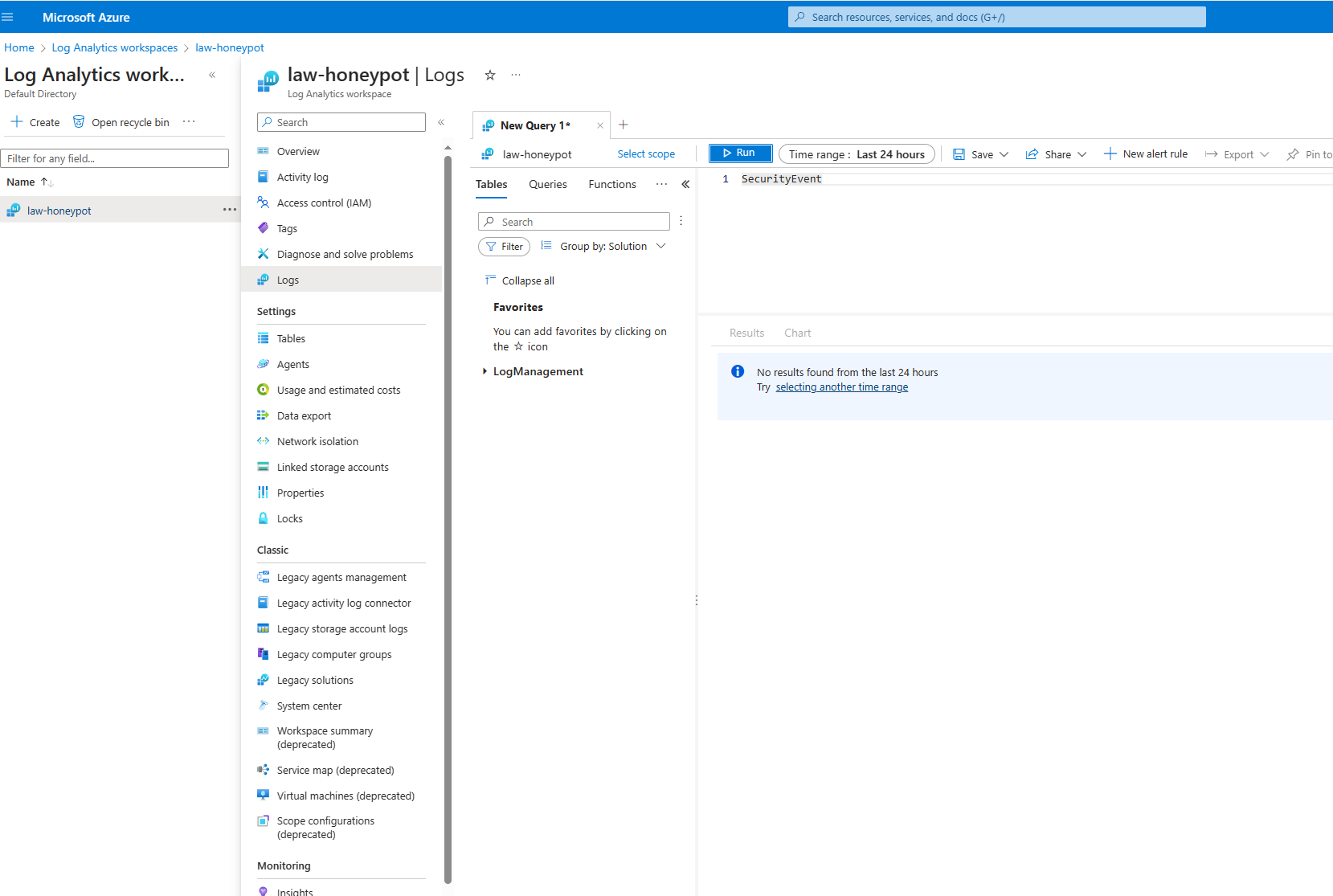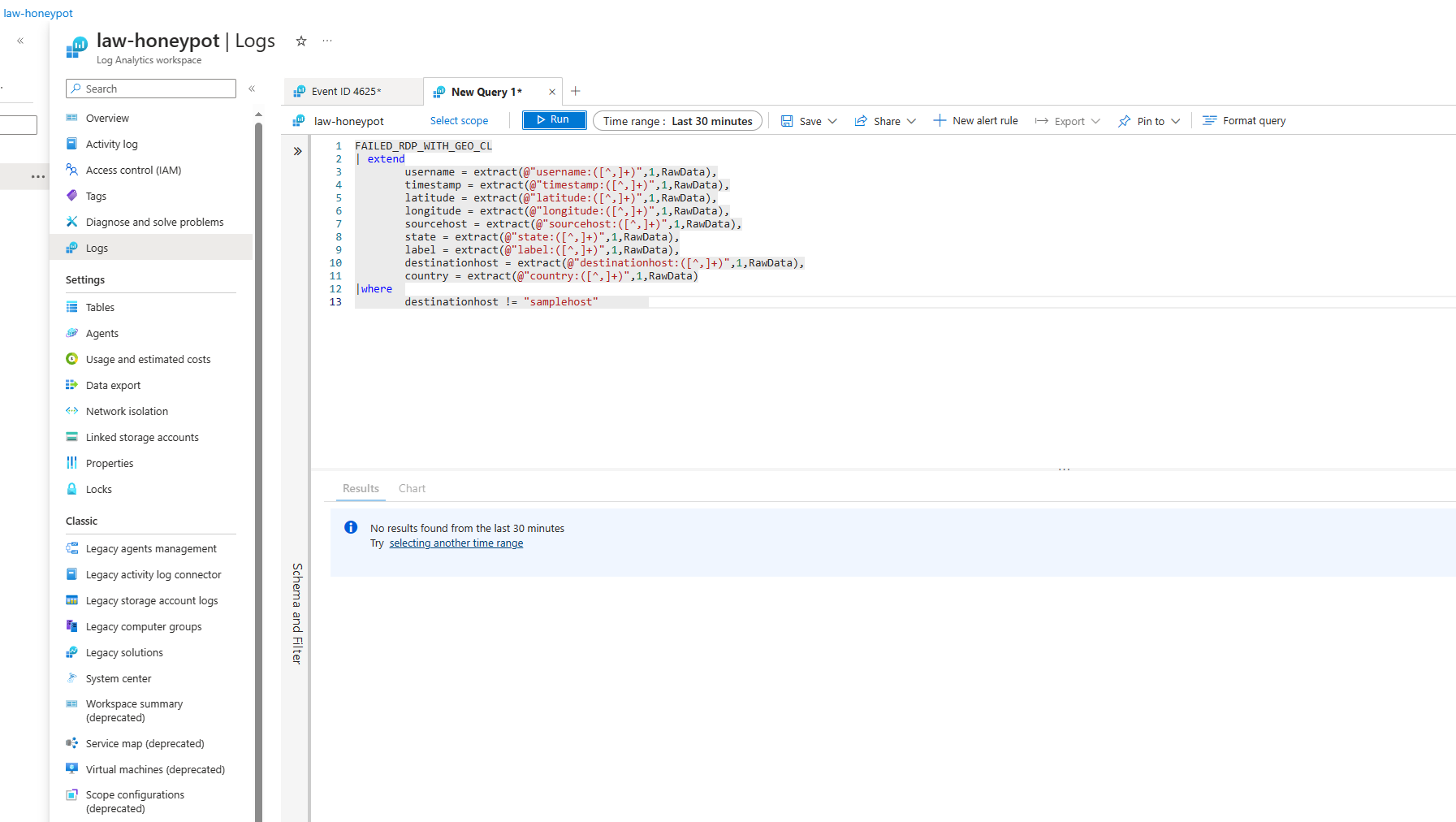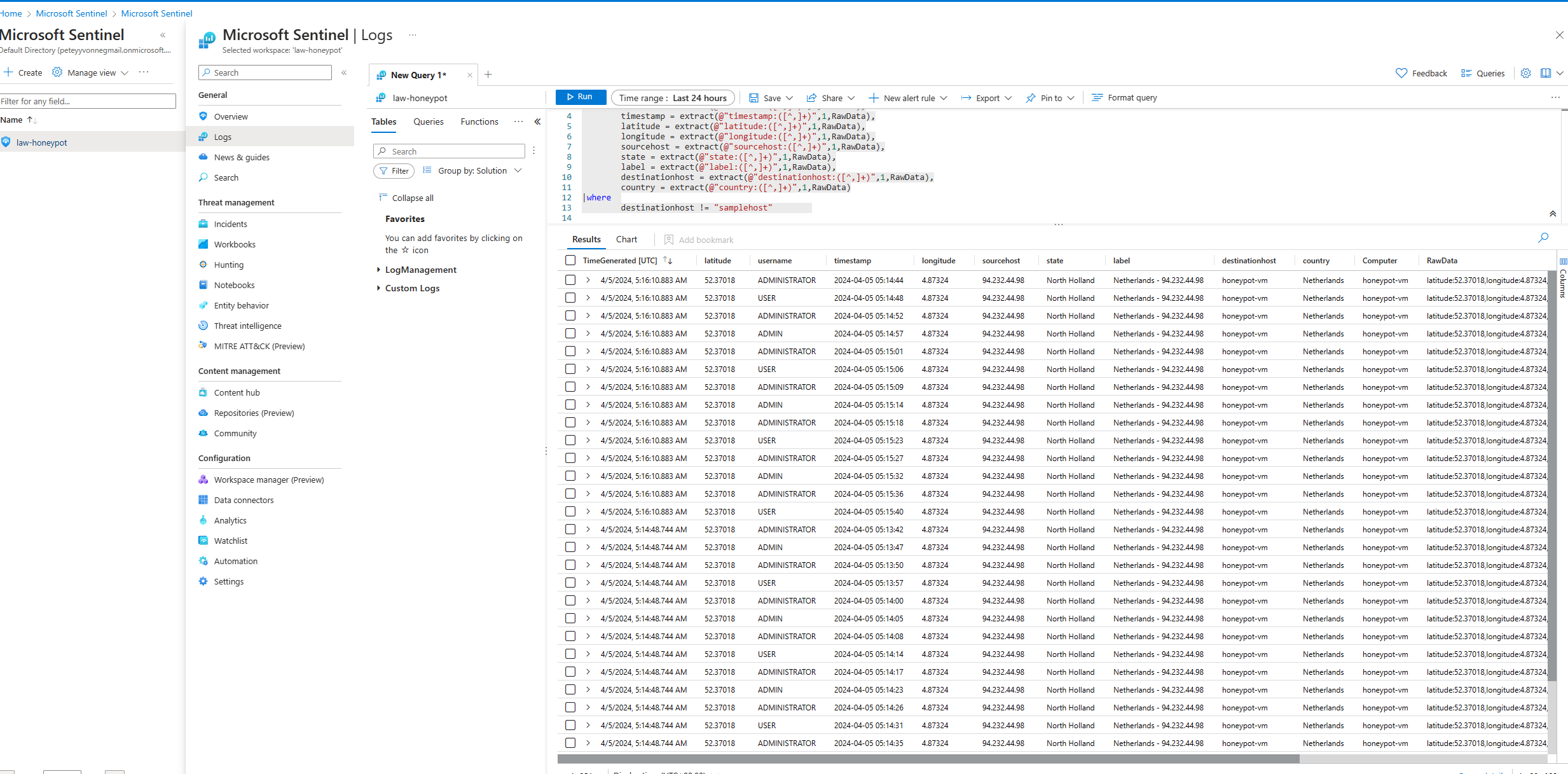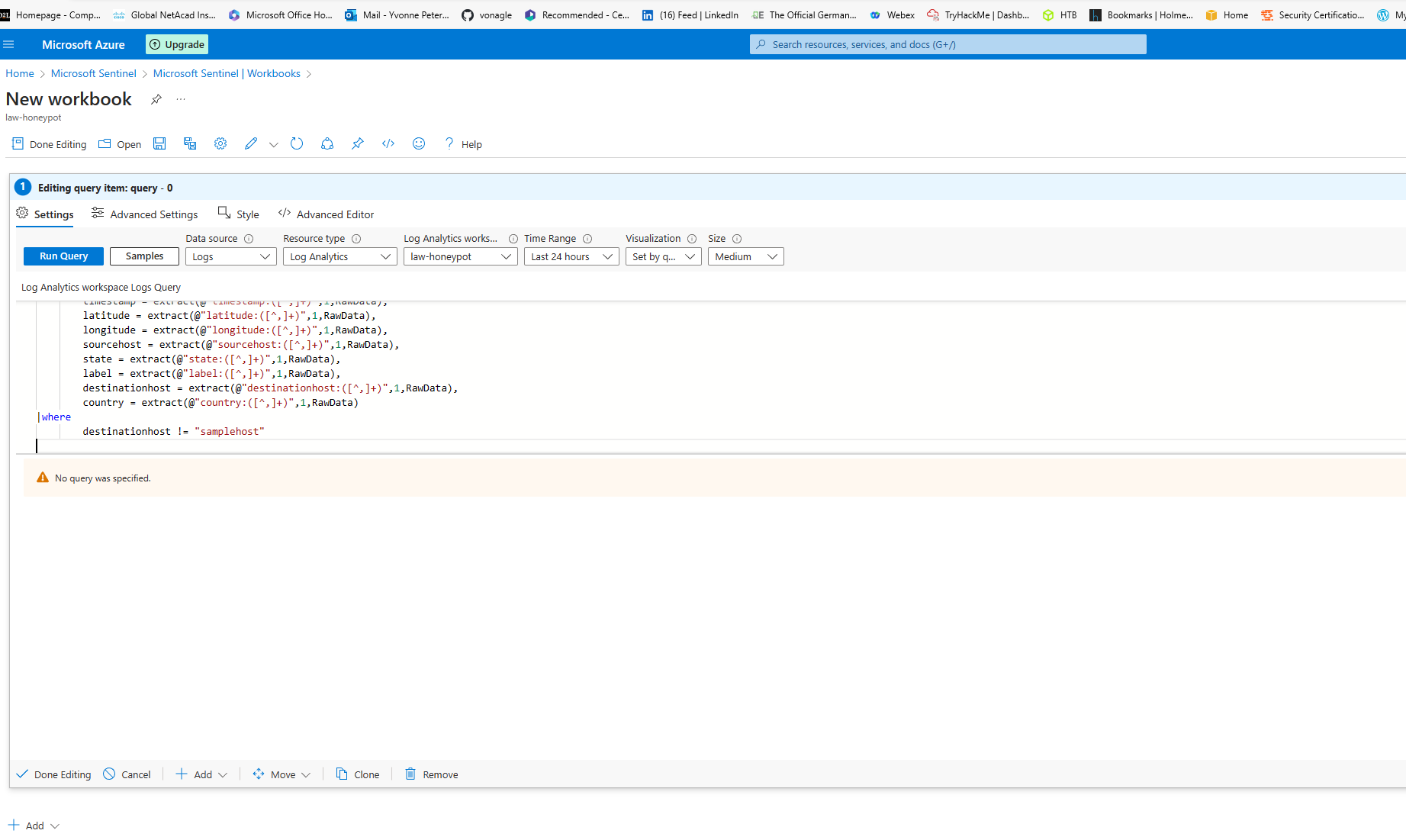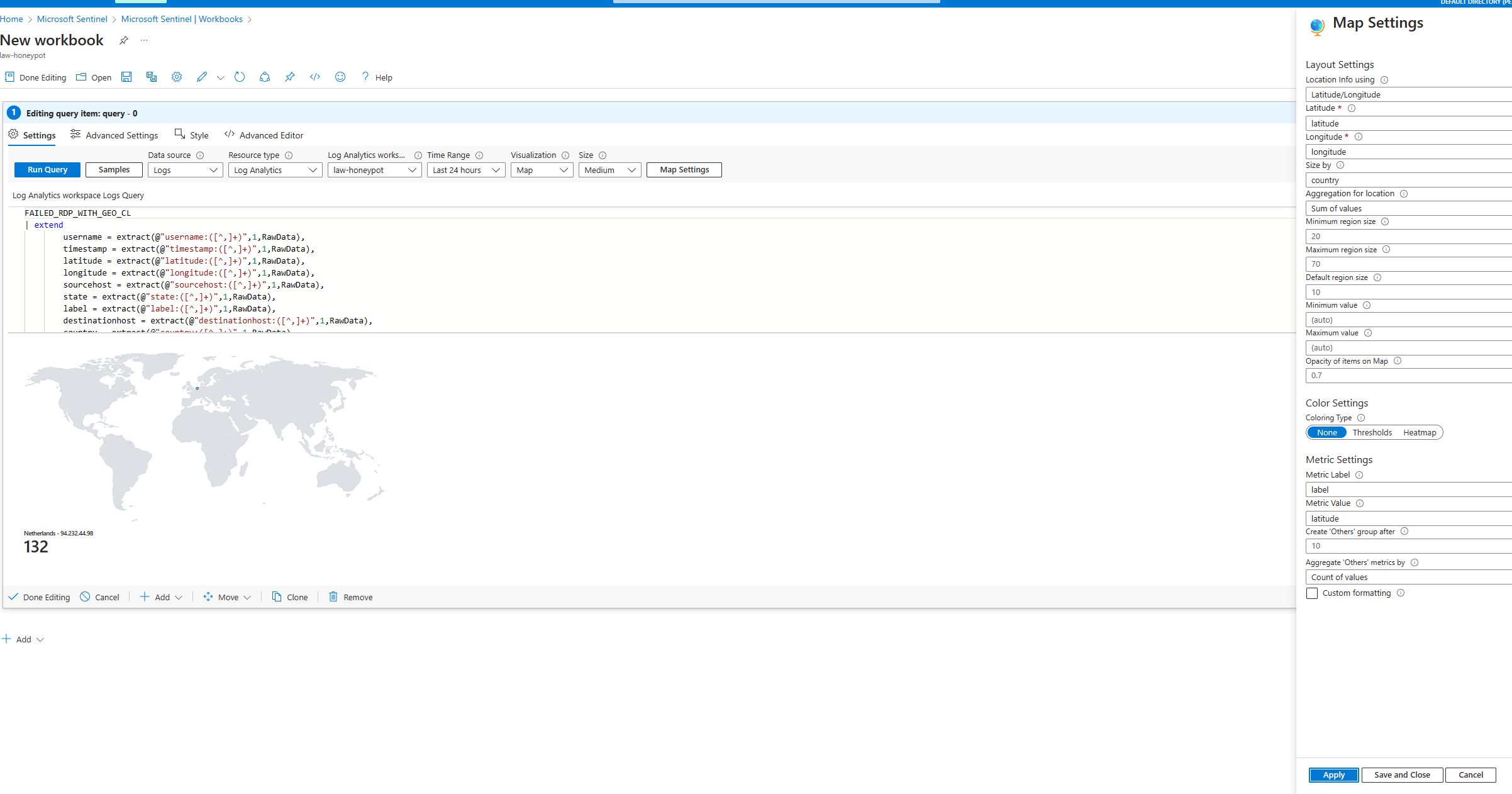Azure Sentinel Lab
by C. Casquatch
Project includes the setup Azure Sentinel (SIEM) and its’ connection to a live virtual machine, acting as a honey pot. I observed live attacks (RDP Brute Force) from all around the world. I used a custom PowerShell script (provided by Josh Madakor) to look up the attackers Geolocation information and plot it on the Azure Sentinel Map. Also thanks to Nirakar Sapkota for the query script.
Languages and Utilities Used
- PowerShell
- Azure Sentinel
Environments Used
- Windows 10
- Microsoft Azure
Create a failed_rdp_script.txt and use the below code for the file body
# Get API key from here: https://ipgeolocation.io/
$API_KEY = "your private key goes here"
$LOGFILE_NAME = "failed_rdp.log"
$LOGFILE_PATH = "C:\ProgramData\$($LOGFILE_NAME)"
# This filter will be used to filter failed RDP events from Windows Event Viewer
$XMLFilter = @'
<QueryList>
<Query Id="0" Path="Security">
<Select Path="Security">
*[System[(EventID='4625')]]
</Select>
</Query>
</QueryList>
'@
<#
This function creates a bunch of sample log files that will be used to train the
Extract feature in Log Analytics workspace. If you don't have enough log files to
"train" it, it will fail to extract certain fields for some reason -_-.
We can avoid including these fake records on our map by filtering out all logs with
a destination host of "samplehost"
#>
Function write-Sample-Log() {
"latitude:47.91542,longitude:-120.60306,destinationhost:samplehost,username:fakeuser,sourcehost:24.16.97.222,state:Washington,country:United States,label:United States - 24.16.97.222,timestamp:2021-10-26 03:28:29" | Out-File $LOGFILE_PATH -Append -Encoding utf8
"latitude:-22.90906,longitude:-47.06455,destinationhost:samplehost,username:lnwbaq,sourcehost:20.195.228.49,state:Sao Paulo,country:Brazil,label:Brazil - 20.195.228.49,timestamp:2021-10-26 05:46:20" | Out-File $LOGFILE_PATH -Append -Encoding utf8
"latitude:52.37022,longitude:4.89517,destinationhost:samplehost,username:CSNYDER,sourcehost:89.248.165.74,state:North Holland,country:Netherlands,label:Netherlands - 89.248.165.74,timestamp:2021-10-26 06:12:56" | Out-File $LOGFILE_PATH -Append -Encoding utf8
"latitude:40.71455,longitude:-74.00714,destinationhost:samplehost,username:ADMINISTRATOR,sourcehost:72.45.247.218,state:New York,country:United States,label:United States - 72.45.247.218,timestamp:2021-10-26 10:44:07" | Out-File $LOGFILE_PATH -Append -Encoding utf8
"latitude:33.99762,longitude:-6.84737,destinationhost:samplehost,username:AZUREUSER,sourcehost:102.50.242.216,state:Rabat-Salé-Kénitra,country:Morocco,label:Morocco - 102.50.242.216,timestamp:2021-10-26 11:03:13" | Out-File $LOGFILE_PATH -Append -Encoding utf8
"latitude:-5.32558,longitude:100.28595,destinationhost:samplehost,username:Test,sourcehost:42.1.62.34,state:Penang,country:Malaysia,label:Malaysia - 42.1.62.34,timestamp:2021-10-26 11:04:45" | Out-File $LOGFILE_PATH -Append -Encoding utf8
"latitude:41.05722,longitude:28.84926,destinationhost:samplehost,username:AZUREUSER,sourcehost:176.235.196.111,state:Istanbul,country:Turkey,label:Turkey - 176.235.196.111,timestamp:2021-10-26 11:50:47" | Out-File $LOGFILE_PATH -Append -Encoding utf8
"latitude:55.87925,longitude:37.54691,destinationhost:samplehost,username:Test,sourcehost:87.251.67.98,state:null,country:Russia,label:Russia - 87.251.67.98,timestamp:2021-10-26 12:13:45" | Out-File $LOGFILE_PATH -Append -Encoding utf8
"latitude:52.37018,longitude:4.87324,destinationhost:samplehost,username:AZUREUSER,sourcehost:20.86.161.127,state:North Holland,country:Netherlands,label:Netherlands - 20.86.161.127,timestamp:2021-10-26 12:33:46" | Out-File $LOGFILE_PATH -Append -Encoding utf8
"latitude:17.49163,longitude:-88.18704,destinationhost:samplehost,username:Test,sourcehost:45.227.254.8,state:null,country:Belize,label:Belize - 45.227.254.8,timestamp:2021-10-26 13:13:25" | Out-File $LOGFILE_PATH -Append -Encoding utf8
"latitude:-55.88802,longitude:37.65136,destinationhost:samplehost,username:Test,sourcehost:94.232.47.130,state:Central Federal District,country:Russia,label:Russia - 94.232.47.130,timestamp:2021-10-26 14:25:33" | Out-File $LOGFILE_PATH -Append -Encoding utf8
}
# This block of code will create the log file if it doesn't already exist
if ((Test-Path $LOGFILE_PATH) -eq $false) {
New-Item -ItemType File -Path $LOGFILE_PATH
write-Sample-Log
}
# Infinite Loop that keeps checking the Event Viewer logs.
while ($true)
{
Start-Sleep -Seconds 1
# This retrieves events from Windows EVent Viewer based on the filter
$events = Get-WinEvent -FilterXml $XMLFilter -ErrorAction SilentlyContinue
if ($Error) {
#Write-Host "No Failed Logons found. Re-run script when a login has failed."
}
# Step through each event collected, get geolocation
# for the IP Address, and add new events to the custom log
foreach ($event in $events) {
# $event.properties[19] is the source IP address of the failed logon
# This if-statement will proceed if the IP address exists (>= 5 is arbitrary, just saying if it's not empty)
if ($event.properties[19].Value.Length -ge 5) {
# Pick out fields from the event. These will be inserted into our new custom log
$timestamp = $event.TimeCreated
$year = $event.TimeCreated.Year
$month = $event.TimeCreated.Month
if ("$($event.TimeCreated.Month)".Length -eq 1) {
$month = "0$($event.TimeCreated.Month)"
}
$day = $event.TimeCreated.Day
if ("$($event.TimeCreated.Day)".Length -eq 1) {
$day = "0$($event.TimeCreated.Day)"
}
$hour = $event.TimeCreated.Hour
if ("$($event.TimeCreated.Hour)".Length -eq 1) {
$hour = "0$($event.TimeCreated.Hour)"
}
$minute = $event.TimeCreated.Minute
if ("$($event.TimeCreated.Minute)".Length -eq 1) {
$minute = "0$($event.TimeCreated.Minute)"
}
$second = $event.TimeCreated.Second
if ("$($event.TimeCreated.Second)".Length -eq 1) {
$second = "0$($event.TimeCreated.Second)"
}
$timestamp = "$($year)-$($month)-$($day) $($hour):$($minute):$($second)"
$eventId = $event.Id
$destinationHost = $event.MachineName# Workstation Name (Destination)
$username = $event.properties[5].Value # Account Name (Attempted Logon)
$sourceHost = $event.properties[11].Value # Workstation Name (Source)
$sourceIp = $event.properties[19].Value # IP Address
# Get the current contents of the Log file!
$log_contents = Get-Content -Path $LOGFILE_PATH
# Do not write to the log file if the log already exists.
if (-Not ($log_contents -match "$($timestamp)") -or ($log_contents.Length -eq 0)) {
# Announce the gathering of geolocation data and pause for a second as to not rate-limit the API
#Write-Host "Getting Latitude and Longitude from IP Address and writing to log" -ForegroundColor Yellow -BackgroundColor Black
Start-Sleep -Seconds 1
# Make web request to the geolocation API
# For more info: https://ipgeolocation.io/documentation/ip-geolocation-api.html
$API_ENDPOINT = "https://api.ipgeolocation.io/ipgeo?apiKey=$($API_KEY)&ip=$($sourceIp)"
$response = Invoke-WebRequest -UseBasicParsing -Uri $API_ENDPOINT
# Pull Data from the API response, and store them in variables
$responseData = $response.Content | ConvertFrom-Json
$latitude = $responseData.latitude
$longitude = $responseData.longitude
$state_prov = $responseData.state_prov
if ($state_prov -eq "") { $state_prov = "null" }
$country = $responseData.country_name
if ($country -eq "") {$country -eq "null"}
# Write all gathered data to the custom log file. It will look something like this:
#
"latitude:$($latitude),longitude:$($longitude),destinationhost:$($destinationHost),username:$($username),sourcehost:$($sourceIp),state:$($state_prov), country:$($country),label:$($country) - $($sourceIp),timestamp:$($timestamp)" | Out-File $LOGFILE_PATH -Append -Encoding utf8
Write-Host -BackgroundColor Black -ForegroundColor Magenta "latitude:$($latitude),longitude:$($longitude),destinationhost:$($destinationHost),username:$($username),sourcehost:$($sourceIp),state:$($state_prov),label:$($country) - $($sourceIp),timestamp:$($timestamp)"
}
else {
# Entry already exists in custom log file. Do nothing, optionally, remove the # from the line below for output
# Write-Host "Event already exists in the custom log. Skipping." -ForegroundColor Gray -BackgroundColor Black
}
}
}
}
THIS QUERY IS BY Nirakar Sapkota, you can find them here: Nirakar-Sapkota
They provide a good video for walking through the last half of the Josh Madakor video, which is a little outdated because of the updates to Azure by Microsoft.
This is the extraction query we use:
FAILED_RDP_WITH_GEO_CL
| extend
username = extract(@"username:([^,]+)",1,RawData),
timestamp = extract(@"timestamp:([^,]+)",1,RawData),
latitude = extract(@"latitude:([^,]+)",1,RawData),
longitude = extract(@"longitude:([^,]+)",1,RawData),
sourcehost = extract(@"sourcehost:([^,]+)",1,RawData),
state = extract(@"state:([^,]+)",1,RawData),
label = extract(@"label:([^,]+)",1,RawData),
destinationhost = extract(@"destinationhost:([^,]+)",1,RawData),
country = extract(@"country:([^,]+)",1,RawData)
|where
destinationhost != "samplehost"
Program walk-through:
In Sentinel; creating our honeypot VM. Below are the configuration settings we will be using
In Sentinel; Creating our Log Analytics work space
In Sentinel; Connecting the VM to the Log Analytics work space
Remoting from our desktop into our VM and providing confiurations
In Sentinel; Creating custom logs for our analytics work space
In Sentinel; Generating a query to extract custom fields from the existing raw data field
In Sentinel; Running the query from the last screenshot
In Sentinel; Creating a workbook to provide a visualisation of the honeypot attacks
In Sentinel; Map of attacks on our honeypot VM
tags: azure - SIEM - sentinel - SOC
